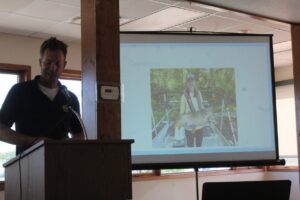(story by Dana Larsen)
Lake Preservation Association leader Ryan Mohr cited “exceptional partnerships” with the City of Storm Lake and the Department of Natural Resources, during the recent annual meeting of nonprofit this week.
“We had a great year,” Mohr said. The season has seen a major re-armoring project on the shoreline at Frank Starr Park, and the beginning of a lake vegetation management project this week, both made possible by such partnerships. Also, the LPA is raising funds toward a memorial for its former president Gary Lalone, who for many years was a leader in efforts to protect and improve the lake.
Plans for upcoming projects include a disability-accessible ramp for Kiwanis Beach near Frank Starr Park, and more shoreline armoring.
DNR fisheries biologist Ben Wallace said the shoreline project is the largest of its kind that he has seen in his tenure. “I’ve also never seen a contractor take such care laying rock,” he said of the work this spring. The armoring replaces limestone, which breaks down over time, with durable fieldstone. The $200,000 project is a good example of state/local partnership, Wallace said, noting that having local matching funds and commitment makes it easier to win state approval for projects.
The lake vegetation project was approved early this year by the Lake Improvement Commission, which includes local governments, in cooperation with the DNR. Chemicals were applied Thursday to discourage overgrowth of vegetation and algae, while presenting no restriction to water recreation.
The DNR expert also spoke about the condition of the lake. Spring netting indicated that the fish in the lake are in good condition, and a new slot limit on walleye is expected to allow more harvesting of fully-grown male fish without a negative impact on the overall fish population. “Hopefully the anglers are enjoying the resource,” Wallace said. The DNR will closely monitor the impact of the protected slot change – it could take five to seven years to fully document that impact. The population of rough fish seems to be down.
Aquatic plant life in the lake has been increasing over the past couple of years, Wallace said. With completion of dredging, lake clarity improved, and as sunlight penetrates deeper into the water, the opportunity for vegetation increased. All of the growth seen to date is of plants native to the area, and is considered normal.
“It’s almost impossible to micromanage water clarity,” Wallace told the gathering at the golf course clubhouse. Several factors can affect clarity.
During the summer of 2021, there was a heavy bloom of cyanobacteria (also called blue-green algae). Blooms are more likely when there is a high nutrient load in the water, and especially under drought conditions. In a shallow lake like Storm Lake, a drop of two feet in water level could represent as much as 40 percent of the lake volume, concentrating nutrient pollution. The “scum mat” of algae tends to block sunlight from penetrating the water, and submerged plants may die off, losing root systems that are good for holding sediment in place on the lakebed.
Wind is also a factor in turbidity – the cloudy look of the lake when lots of sediment particles are suspended in the water. “I can’t remember a spring with this much wind,” Wallace said.
While walleye fishing may be good in turbid conditions, the populations of bluegill and largemouth bass that have been coming on recently in Storm Lake could suffer if the water remains cloudy.
It’s difficult to predict weather and lake conditions ahead, so vegetation management is generally based on the experiences of the year before. Wallace said the chemicals were only being used in areas where public benefit could be expected – Awaysis Beach, the marina area, Kiwanis Beach, University Cove near Scout Park and around the King’s Pointe resort docks. These areas represent about 30 acres or 1 percent of the total lake area.
The fisheries biologist is quick to note that the goal is not to kill off all the submerged plants. They are an important part of the ecosystem for a healthy lake.
Invasive zebra mussels may be in a down cycle after an initial population explosion in the lake, Wallace said. The first year they are present there will be only a small number, the second year hundreds, and later, the population peaks to the point where the mussels “eat themselves out of house and home” and the population drops dramatically. “I’m convinced we will always have them,” Wallace said. “They will go down, come back, and reach a balance eventually.”
Low water level is not particularly a concern. It is normal for northwest Iowa to experience a drought cycle roughly every eight to 12 years. “It’s healthy for lakes to go through a drought period,” according to Wallace.
(pictured above…DNR Fisheries Biologist Ben Wallace speaks on the lake’s health, showing a photo of a massive carp that was caught during a survey earlier in this year)











